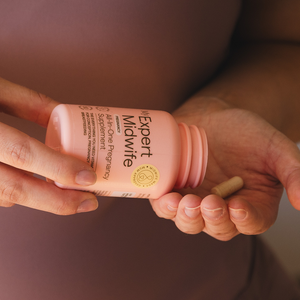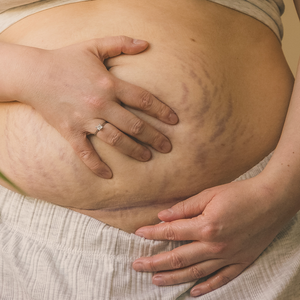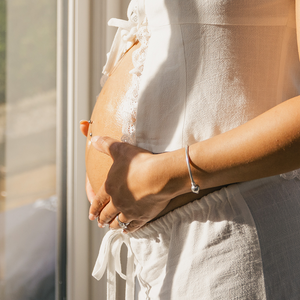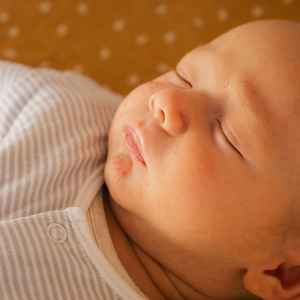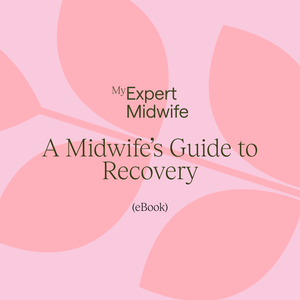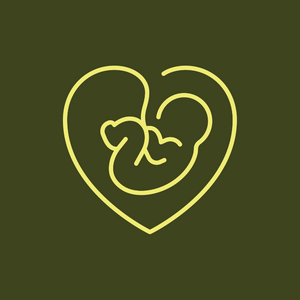Did you know that after you have had an operation regularly massaging the scar tissue can be beneficial to help improve the healing process?
Once skin and muscle tissues have been cut they undergo a healing process externally and internally. Age and skin type can influence how a scar can heal and how long it can take, but massaging the area can also help.
During healing scar tissue can adhere (stick) to other tissues and organs after an operation creating adhesions. These are bands of scar tissue that can tighten and constrain external skin and internal tissues.
As scar tissue forms slowly, regularly massaging the area can encourage it to form flatter improving the appearance externally as well as helping to soften adhesions internally, improving movement and reducing tightness.
How to massage a C-section scar
Healing takes time and occurs in 4 stages. During surgery your abdomen is incised, your wound is repaired and healing commences. Here are the stages of the healing process:
- The first stage is haemostasis, where clotting factors in your blood stop the bleeding
- The second phase (inflammation stage) is the scabbing over and clearing away of toxins and infections
- The third phase (proliferation stage) is the rebuilding stage and this is when you can benefit the most from massaging your scar. Once healed and formed it can feel itchy and sensitive as the nerve endings within the tissue are actively healing. It may feel numb in places or tingly to the touch or even painful if pressed on. It still looks red at this point but does fade over time to normal skin tone
- The fourth phase (maturation stage) is when the scar strengthens. Your body can still be forming scar tissue for more than a year after your C-Section. When scar tissue is no longer being produced by the body, the scar is considered mature. Even at this point, massaging can still be beneficial
How to Massage a C Section Scar in 3 stages
Stage 1- the skin
You can begin gentle massage after your 6 week check-up, or sooner if the scar is considered well healed. Initially, the scar may be quite tender, red, and painful and it may be best to work around the actual scar itself, working the tissues above and below it. As the scar becomes less tender, you can follow this procedure with your fingers directly on top of the scar itself:
- Wear loose comfy clothes with easy access to the scar area and have your legs out straight and relaxed
- First massage the skin gently around the scar with the oil
- Place your fingertips lightly on the skin above the scar and see how mobile the skin is by moving it up and down and side-to-side
- If it moves down more than it does up, that’s normal, try to move it more in the upward direction. Does it move more easily on one side than the other? Are you sore on one side? This is also normal. Discomfort is okay but not too much pain, be conscious about trying to relax too.
- If you find a stiff or tight zone, maintain your hold there and breathe – you may feel a release or the tissues relaxing
- Use your fingers to move your skin up and down, side to side, and also in little circles. Start by working the tissues around the scar, and later include on top of the scar as much as your pain and tenderness allows. Eventually, you will be able to pick the skin of the scar up and roll it between your fingertips
Stage 2- muscle layer
Just below the skin and fat is the muscular layer and you may or may not feel your abdominal muscles, but they are there. It is ok to feel slightly uncomfortable during this massage but it should not be painful.
- Allow your fingers to melt deeper into your abdomen and check to see how this layer of tissues move
- If one side moves less than the other side this is totally normal. Most people find one side of the scar is more restricted than the other side. This may be that the knot from the stitches finished on that side or that some nerves have been compressed, but there usually is a side which is more sore
- Do the same movements as with the skin, keeping fingers deep and embedded in the flesh, moving them up, down, side-to-side, and small circles around the scar
- Have your fingers on top of the scar as much as any tenderness allows. Adhesions where the scar tissue attaches on to your bowel can occur so you can work further out and around from the scar as you would like to
- Focus on any area of tightness to encourage movement in that direction by moving the tissues to where they don’t want to go and then gently holding them there for a few seconds
- You may feel a slight burning sensation, which is normal for stretching tissues. Hold until you feel a softening or melting of the tissues or the feeling that the scar tissue is releasing a little under your fingers
- Do not be too heavy handed with the massage– go at your own pace- just until you feel some softening and improvement in the area under your fingers
- Do not use extreme forcing as this can cause tissue tightening, where it will refuse to release
- Most importantly relax, breathe and massage to the point of tenderness not extreme pain
Stage 3- deep muscle
The last stage you are working down at quite a deep level. If you’ve ever been checked for appendicitis or had kidney problems, a doctor felt your abdomen this way- it is a massage which is firmly moving the deeper tissues.
- Bend your knees to slacken your lower abdominal tissues. This helps you to massage the deepest layer
- Remember, your fingers need to sink deeper into the tissues around your scar area
- Massage at your scar level on the surface, but also lower near the pubic bone. Try to sink further into the muscles and see if you can move these deeper tissues side-to-side and up and down
- This deeper level massage can prevent you from developing lower back pain or frequency of urination in years to come
- Make sure both sides are massaged well and feel equally mobile. If one side is tighter, then take the massage in the direction it doesn’t want to move in, until you can’t move it any further. Gently hold it there until you feel the tissues melting and releasing under your fingers.
- Relax and breathe deeply then recheck the tissue’s mobility to see if it feels the same from side-to-side
When to massage
This is a guide to the frequency of massaging, but everyone is different, so develop a routine that feels comfortable for you.
- Once you are ready to start in the first few weeks after the birth, begin with 5 minutes daily until your tissues are freely moving in all directions with all 3 layers. This may take a few weeks or longer- everyone is different
- Then reduce to a weekly massage, noticing any stiff or tight areas and working with them
- Then you may want to simply massage the area every so often- maybe monthly. The week after your period finishing is a good time as you won’t have any additional tenderness or irritation
- This massage routine is a good thing to do monthly to 6 weekly up until the 2 year mark from the birth
- If you find the tissues getting tight again, slip back into a more regular weekly pattern of massaging
How to massage an episiotomy scar or a scar tissue from a tear
An episiotomy is a cut to the perineum made by a doctor or midwife (with your consent) to widen the vaginal opening during the birth of your baby. It could be advised during a normal birth if there are concerns about your baby’s heartrate, requiring your baby to be delivered quickly, or if you need an instrumental delivery, such as forceps, to help prevent a tear that could damage your back passage. It is a surgical cut and will need to be repaired with stitches.
The healing process for an episiotomy can be from a few weeks to several months, depending on individual circumstances which can include your own health, the size of the cut that was made or whether an infection develops. Tears tend to heal better and more quickly than episiotomies but, again, can be affected by individual circumstances.
Once your scar has completed the healing process it can still feel tender or slightly painful to touch, so you need to decide when you feel comfortable to start trying to massage it. As scar tissue tends to develop quite slowly, massaging the area regularly helps to loosen the tissues as they form so they feel less rigid and tight, and can also help them to form in a flatter shape. Releasing the amount of tightness in the scar tissue can also increase elasticity in the perineum, which can be beneficial if your scar is causing you discomfort. This can help if sex is feeling uncomfortable and may be beneficial in helping the scar stretch more easily during future births.
How to massage episiotomy scar or scar tissue from a tear
You can begin gentle massage after your 6 week check-up, or sooner if the scar is considered well healed. Initially, the scar may be quite tender, red, and painful and it may be best to work around the actual scar itself. As the scar becomes less tender, you can follow this procedure with your fingers directly on top of the scar:
- You may want to have a warm bath or shower first as this can help you relax and soften the area. Find a time when you are unlikely to be disturbed and try relaxing on the bed or a comfy place where you have easy access to the scar area
- First, massage the skin gently around the scar with the oil
- Place your fingertips lightly on the skin and start by working the tissues around the scar
- Use your fingers to move your skin up and down, side to side, and also in little circles
- Discomfort is okay but it shouldn’t be painful. Take note of how it feels and be conscious about trying to relax
- If you find a stiff or tight zone, maintain your hold there and breathe – you may feel a release or the tissues relaxing
When to massage
This is a guide to the frequency of massaging. Everyone is different, though, so develop a routine that feels comfortable for you.
- Once you are ready to start, in the first few weeks after the birth, aim to massage the area for 5 minutes daily until you feel that the tightness around your scar is reducing and you are more comfortable. This may take a few weeks, or longer - everyone is different
- Then, reduce to a weekly massage, noticing any stiff or tight areas and working with them
- After this, you may want to simply massage the area every so often - maybe monthly
- Routine scar massage can be beneficial up until the 2-year mark from the birth of your baby
- If you find the tissues getting tight again, slip back into a more regular weekly pattern of massaging
How to massage scars and scar tissue
What is scar tissue?
Scars can be the result of an injury or from surgery you have had. The process of healing begins as soon as the wound is starting to heal and can still be ongoing at a cellular level for 1-2 years. Scar tissue forms as your body lays healing fibres down to repair the incised or damaged tissues, such as skin, fat, muscle etc.
During the healing process, scar tissue may adhere to other tissues creating adhesions. These are bands of scar tissue that can tighten and constrain external skin and internal tissues. Scar tissue forms slowly and as it does it can be encouraged to form flatter by massaging the scar area.
Age and skin type can influence how a scar can heal and how long it can take. The longer it takes to heal the thicker it can form. Massaging a scar usually improves tissue movement and tightness as well as improving its appearance externally.
Healing takes time and occurs in 4 stages. Here are the stages of the healing process:
- The first stage is haemostasis, where clotting factors in your blood stop the bleeding
- The second phase (inflammation stage) is the scabbing over and clearing away of toxins and infections
- The third phase (proliferation stage) is the rebuilding stage and this is when you can benefit the most from massaging your scar. Once healed and formed it can feel itchy and sensitive as the nerve endings within the tissue are actively healing. It may feel numb in places or tingly to the touch, painful if pressed on and may look red
- The fourth phase (maturation stage) is when the scar strengthens. Your body can still be forming scar tissue for more than a year. When scar tissue is no longer being produced by the body, the scar is considered mature, but massaging can still be beneficial
Scar tissue can continue to develop and change for around 12-18 months, but the sooner you begin scar massage the easier it is to manipulate and the less likely it is to cause any long-term problems.
Benefits of scar massage are:
- It can reduce sensitivity and tenderness
- Improve the tone and colour by reducing redness and/or other colouring
- Moisturise and reduce itchiness
- Improve scar mobility and reduce tightness
- Help scar tissue form flatter and less raised
How to massage your scar:
You can begin gentle massage when the scar is considered well healed. Initially, the scar may be quite tender, red, and painful and it may be best to work around the actual scar itself, working the tissues above and below it. As the scar becomes less tender, you can follow this procedure with your fingers directly on top of the scar itself:
- Wear loose comfy clothes with easy access to the scar area and choose a time when you feel relaxed
- First massage the skin gently around the scar with the oil
- Place your fingertips lightly on the skin above the scar and see how mobile the skin is by moving it up and down and side-to-side
- If it moves down more than it does up, that’s normal, try to move it more in the upward direction. Does it move more easily on one side than the other? Are you sore on one side? This is also normal. Discomfort is okay but not too much pain, be conscious about trying to relax too.
- If you find a stiff or tight zone, maintain your hold there and breathe – you may feel a release or the tissues relaxing
- Use your fingers to move your skin up and down, side to side, and in little circles. Start by working the tissues around the scar, and later include on top of the scar as much as tenderness allows. Eventually, you will be able to pick the skin of the scar up and roll it between your fingertips
When to massage
This is a guide to the frequency of massaging, but everyone is different, so develop a routine that feels comfortable for you:
- Once you are ready to start begin with 5 minutes daily until tissues are freely moving in all directions. This may take a few weeks or longer- everyone is different
- Then reduce to a weekly massage, noticing any stiff or tight areas and working with them
- Then you may want to simply massage the area every so often- maybe monthly
- This massage routine is a good thing to do monthly up until the 2 year mark
- If you find the tissues getting tight again, slip back into a more regular weekly pattern of massaging
